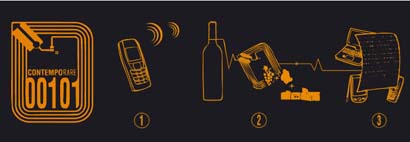Wireless message in a bottle
 Riders of public transport in Chicago or Oslo know RFID technology. Bump your wallet at the turnstile and off you go–no fumbling to swipe cards. Same with skiers at some ski resorts. And drivers in the Northeast know the technology as well through E-ZPass toll collection.
Riders of public transport in Chicago or Oslo know RFID technology. Bump your wallet at the turnstile and off you go–no fumbling to swipe cards. Same with skiers at some ski resorts. And drivers in the Northeast know the technology as well through E-ZPass toll collection.
The same technology is coming to wine. Through an RFID sensor placed in the (synthetic) cork, importers, stores and consumers can now give each bottle a unique ID. While barcodes SKUs work for all the bottles of a certain wine as a group, this technology gives each individual bottle a unique–and unchangeable–ID. And unlike bar codes, boxes don’t have to be opened nor bottles taken off shelves to see more info about the wine. You just need to wave an RFID reader, which even comes in some Nokia phones, about 2 inches from the bottle and voila, all the info gets displayed.
The implications for consumers could be big. At the cost of $0.50 each though to the winery, it’s most likely impact will be on higher-end wines. Given the problem of fraud at auction, this would put an end to wondering if you bought the real deal or not. Optional fields could trace the bottle’s previous owners and even track the hammer prices. Sadly though the technology is difficult to put into real corks and the uptake of synthetic corks in cult wines remains almost nonexistent. It is currently available in one wine, the Contemporare from Arnaldo-Caprai, an excellent sangiovese (find this wine).
But it could have an important impact on everyday drinking wines too. An optional setting could add a temperature sensor that tracks max and min temperatures during shipping. If consumers could buy a bottle with the knowledge that it hadn’t been cooked in transit, that’s something to which we could all raise a glass–and our RFID readers!
 tags: wine | wine technology | RFID
tags: wine | wine technology | RFID




On April 3rd, 2006 at 1:58 pm ,bobzaguy wrote:
This is way too much Dr!
At 50¢ per, it’s worth more than the plonk that is in “everyday” stuff! Just force the producers to bag-box it or screwcap it.
The wine was made to drink yesterday in most cases! Today is already too late!
responding to this from your post:
But it could have important impact on everyday drinking wines too. An optional setting could add a temperature sensor that tracks max and min temperatures during shipping. If consumers could buy a bottle with the knowledge that it hadn’t been cooked in transit, that’s something to which we could all raise a glass–and our RFID readers!